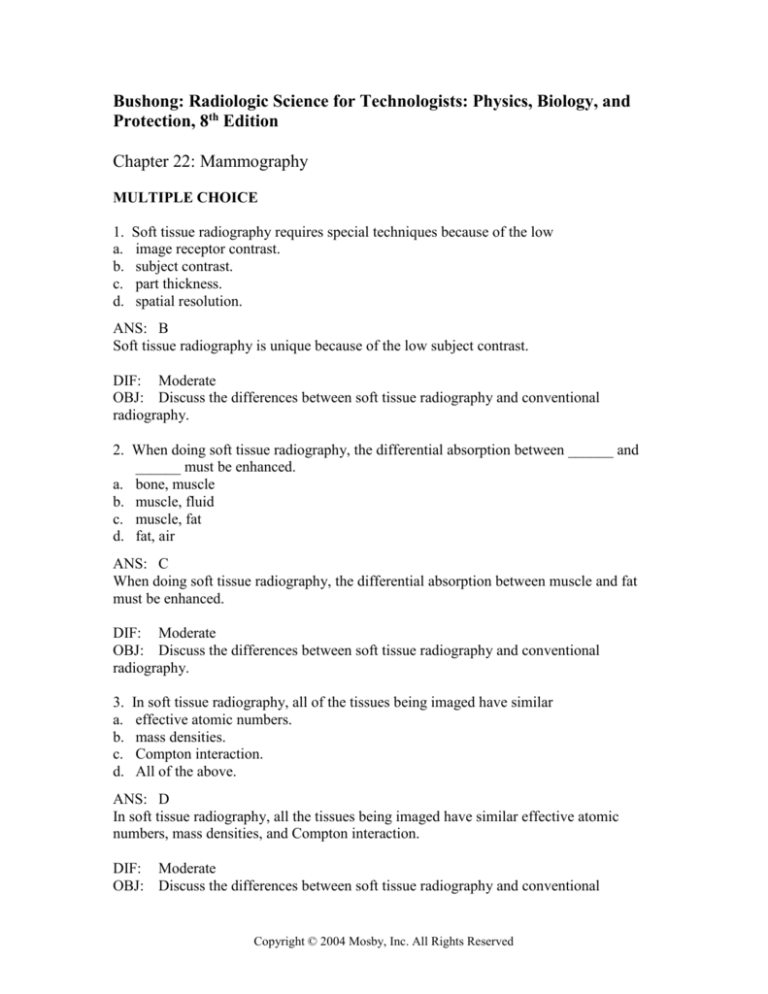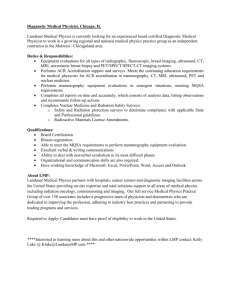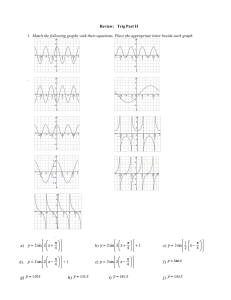
Bushong: Radiologic Science for Technologists: Physics, Biology, and
Protection, 8th Edition
Chapter 22: Mammography
MULTIPLE CHOICE
1.
a.
b.
c.
d.
Soft tissue radiography requires special techniques because of the low
image receptor contrast.
subject contrast.
part thickness.
spatial resolution.
ANS: B
Soft tissue radiography is unique because of the low subject contrast.
DIF: Moderate
OBJ: Discuss the differences between soft tissue radiography and conventional
radiography.
2. When doing soft tissue radiography, the differential absorption between ______ and
______ must be enhanced.
a. bone, muscle
b. muscle, fluid
c. muscle, fat
d. fat, air
ANS: C
When doing soft tissue radiography, the differential absorption between muscle and fat
must be enhanced.
DIF: Moderate
OBJ: Discuss the differences between soft tissue radiography and conventional
radiography.
3.
a.
b.
c.
d.
In soft tissue radiography, all of the tissues being imaged have similar
effective atomic numbers.
mass densities.
Compton interaction.
All of the above.
ANS: D
In soft tissue radiography, all the tissues being imaged have similar effective atomic
numbers, mass densities, and Compton interaction.
DIF: Moderate
OBJ: Discuss the differences between soft tissue radiography and conventional
Copyright © 2004 Mosby, Inc. All Rights Reserved
Chapter 22: Mammography
2
radiography.
4.
a.
b.
c.
d.
The breast tissue tends to be increasingly ________ in older women.
fatty
dense
glandular
fibrous
ANS: A
The breast tissue tends to be increasingly fatty in older women.
DIF:
5.
a.
b.
c.
d.
Moderate
OBJ: Describe the anatomy of the breast.
About 80% of breast cancer occurs in ________ tissue.
epidermal
adipose
ductal
connective
ANS: C
About 80% of breast cancer occurs in ductal tissue.
DIF:
Moderate
OBJ: Describe the anatomy of the breast.
6. A diagnostic mammogram must be able to demonstrate microcalcifications less than
_______ in size.
a. 5000 mm
b. 3000 mm
c. 1000 mm
d. 500 mm
ANS: D
A diagnostic mammogram must be able to demonstrate microcalcifications less than 500
mm in size.
DIF:
Moderate
OBJ: Describe the anatomy of the breast.
7. The American Cancer Society recommends that all women ____ years of age and
older have an annual screening mammogram.
a. 45
b. 50
c. 55
d. 60
ANS: B
The American Cancer Society recommends that all women 50 years of age and older
have an annual screening mammogram.
Copyright © 2004 Mosby, Inc. All Rights Reserved
Chapter 22: Mammography
3
DIF: Moderate
OBJ: Identify the recommended intervals for self-examination and x-ray examination of
the breast.
8. The American Cancer Society recommends biannual screening mammograms for all
women
a. over age 65.
b. age 30–39.
c. age 50–59.
d. age 40–49.
ANS: D
The American Cancer Society recommends biannual screening mammograms for all
women age 40–49.
DIF: Moderate
OBJ: Identify the recommended intervals for self-examination and x-ray examination of
the breast.
9. It is recommended that women obtain their first baseline mammogram before the age
of ______.
a. 30
b. 40
c. 50
d. 60
ANS: C
It is recommended that women obtain their first baseline mammogram before the age of
50.
DIF: Moderate
OBJ: Identify the recommended intervals for self-examination and x-ray examination of
the breast.
10. A dedicated mammography unit should have an automatic adjustable ________
device.
a. grid
b. compression
c. focal spot
d. filter
ANS: B
A dedicated mammography unit should have an automatic adjustable compression
device.
DIF: Moderate
OBJ: Describe the unique features of a mammographic imaging system.
Copyright © 2004 Mosby, Inc. All Rights Reserved
Chapter 22: Mammography
4
11. Every dedicated mammography unit is equipped with a ___________.
a. low ratio grid
b. high ratio grid
c. three-phase voltage generator
d. tungsten filter
ANS: A
Every dedicated mammography unit is equipped with a low ratio grid.
DIF: Moderate
OBJ: Describe the unique features of a mammographic imaging system.
12. A target of molybdenum or rhodium is preferable in mammography because it
reduces the _______.
a. resolution
b. scatter
c. contrast
d. motion
ANS: B
A target of molybdenum or rhodium is preferable in mammography because it reduces
the scatter.
DIF: Moderate
OBJ: Describe the unique features of a mammographic imaging system.
13. Breast compression has the advantage of lowering
a. patient dose.
b. motion blur.
c. superimpositions.
d. All of the above.
ANS: D
Breast compression has the advantage of lowering patient dose, motion blur, and
superimpositions.
DIF:
Moderate
OBJ: Discuss the requirement for compression in mammography.
14. Breast compression is used to _______ patient dose and _______ focal spot blur.
a. lower, reduce
b. lower, increase
c. raise, reduce
d. raise, increase
ANS: A
Breast compression is used to lower patient dose and reduce focal spot blur.
DIF:
Moderate
OBJ: Discuss the requirement for compression in mammography.
Copyright © 2004 Mosby, Inc. All Rights Reserved
Chapter 22: Mammography
5
15. Breast compression increases
a. contrast resolution.
b. spatial resolution.
c. patient dose.
d. Both a and b.
ANS: D
Breast compression increases contrast resolution and spatial resolution.
DIF:
Moderate
OBJ: Discuss the requirement for compression in mammography.
16. Mammograms are taken with _______ cassettes.
a. double screen
b. single screen
c. non-screen
d. Both a and b.
ANS: B
Mammograms are taken with single screen cassettes.
DIF: Moderate
OBJ: Describe the image receptors used in mammography and the spatial resolution
obtained.
17. The spatial resolution is improved in mammography by always placing the emulsion
side of the film ______ the screen and ______ the tube.
a. away from, away from
b. against, toward
c. against, away from
d. away from, toward
ANS: C
The spatial resolution is improved in mammography by always placing the emulsion side
of the film against the screen and away from the tube.
DIF: Difficult
OBJ: Describe the image receptors used in mammography and the spatial resolution
obtained.
18. Cassettes used in mammography are specially designed with
a. tighter film-screen contact.
b. high Z front covers.
c. double screens.
d. looser spring latches.
ANS: A
Cassettes used in mammography are specially designed with tighter film-screen contact.
Copyright © 2004 Mosby, Inc. All Rights Reserved
Chapter 22: Mammography
DIF: Moderate
OBJ: Describe the image receptors used in mammography and the spatial resolution
obtained.
19. Mammography currently uses _______ film.
a. direct exposure
b. xeroradiography
c. double-emulsion
d. single-emulsion
ANS: D
Mammography currently uses single-emulsion film.
DIF: Moderate
OBJ: Explain the differences between diagnostic and screening mammography.
20. Screening mammography requires ___ view(s) of each breast, whereas diagnostic
mammography requires _________ views.
a. one, two or more
b. two, two or more
c. three, three or more
d. four, four or more
ANS: B
Screening mammography requires two views of each breast, whereas diagnostic
mammography requires two or more views.
DIF: Difficult
OBJ: Explain the differences between diagnostic and screening mammography.
Bushong: Radiologic Science for Technologists: Physics, Biology, and
Protection, 8th Edition
Chapter 23: Mammography Quality Control
MULTIPLE CHOICE
1.
a.
b.
c.
d.
A quality assurance program includes measures of
patient satisfaction.
processor quality control.
equipment function.
All of the above.
ANS: D
A quality assurance program includes measures of patient satisfaction, processor quality
control, and equipment function.
Copyright © 2004 Mosby, Inc. All Rights Reserved
6
Chapter 22: Mammography
DIF: Moderate
assurance.
2.
a.
b.
c.
d.
OBJ: Define quality control and its relationship to quality
The ___________ is responsible for supervising quality assurance.
chief radiologist
mammographer
department manager
medical physicist
ANS: A
The chief radiologist is responsible for supervising quality assurance.
DIF: Moderate
assurance.
OBJ: Define quality control and its relationship to quality
3. The purpose of a quality assurance program is to maintain maximum
_________________ with minimum __________________.
a. equipment function, department costs
b. patient satisfaction, exam time
c. quality mammograms, patient dose
d. patient care, exam time
ANS: C
The purpose of a quality assurance program is to maintain quality mammograms with
minimum patient dose.
DIF: Moderate
assurance.
4.
a.
b.
c.
d.
OBJ: Define quality control and its relationship to quality
The mammography quality control program is outlined by the
radiologist department.
Mammography Quality Standards Act.
state governments.
Bureau of Radiation Health.
ANS: B
The mammography quality control program is outlined by the Mammography Quality
Standards Act.
DIF: Moderate
assurance.
5.
a.
b.
c.
d.
OBJ: Define quality control and its relationship to quality
The average glandular dose to mammography patients must be tested annually by the
mammographer.
radiologist.
medical physicist.
department manager.
Copyright © 2004 Mosby, Inc. All Rights Reserved
7
Chapter 22: Mammography
ANS: C
The average glandular dose to mammography patients must be tested annually by the
medical physicist.
DIF: Moderate
OBJ: Describe the role of the radiologist and the medical physicist in quality control.
6. The team of ________________________ is responsible for mammography quality
control.
a. mammographer and QC technologist
b. mammographer, radiologist, and medical physicist
c. medical physicist, staff manager, and chief radiologist
d. staff manager and medical physicist
ANS: B
The team of mammographer, radiologist, and medical physicist is responsible for
mammography quality control.
DIF:
Moderate
OBJ: List the members of the quality control team in radiology.
7. The ___________ is responsible for selecting the medical physicist and
mammographers responsible for quality control.
a. radiologist
b. department manager
c. chief mammographer
d. federal government
ANS: A
The radiologist is responsible for selecting the medical physicist and mammographers
responsible for quality control.
DIF: Moderate
OBJ: Describe the role of the radiologist and the medical physicist in quality control.
8. The medical physicist is responsible for ______________ performance evaluation of
the imaging equipment.
a. quarterly
b. semiannual
c. biannual
d. annual
ANS: D
The medical physicist is responsible for annual performance evaluation of the imaging
equipment.
DIF: Moderate
OBJ: Describe the role of the radiologist and the medical physicist in quality control.
Copyright © 2004 Mosby, Inc. All Rights Reserved
8
Chapter 22: Mammography
9
9. The _________________ is responsible for measurement of the mammogram viewing
conditions.
a. darkroom technologist
b. mammographer
c. medical physicist
d. radiologist
ANS: C
The medical physicist is responsible for measurement of the mammogram viewing
conditions.
DIF: Moderate
OBJ: Describe the role of the radiologist and the medical physicist in quality control.
10. When is the QC evaluation of the equipment performed?
a. once a year
b. when major components are replaced
c. when repairs are needed
d. Both a and b.
ANS: D
Equipment QC is done annually and when major components are replaced.
DIF: Moderate
OBJ: Describe the role of the radiologist and the medical physicist in quality control.
11. One responsibility of the radiologist is to track
a. patient communications.
b. film repeat analysis.
c. darkroom conditions.
d. equipment performance.
ANS: A
One responsibility of the radiologist is to track patient communications.
DIF: Moderate
OBJ: Describe the role of the radiologist and the medical physicist in quality control.
12. The medical physicist is responsible for the
a. monthly equipment check.
b. quarterly conference with the radiologist.
c. annual artifact evaluation.
d. semiannual compression check
ANS: C
The medical physicist is responsible for the annual artifact evaluation.
Copyright © 2004 Mosby, Inc. All Rights Reserved
Chapter 22: Mammography
10
DIF: Moderate
OBJ: Describe the role of the radiologist and the medical physicist in quality control.
13. The role of medical physicist includes
a. performing annual performance evaluations of equipment.
b. consulting with the mammographers concerning QC.
c. reviewing the QC records to check for compliance.
d. All of the above.
ANS: D
The role of medical physicist includes performing annual performance evaluations of
equipment, consulting with the mammographers concerning QC, and reviewing the QC
records to check for compliance.
DIF: Difficult
OBJ: Describe the role of the radiologist and the medical physicist in quality control.
14. The mammographer should _____________________ on a monthly basis.
a. do a repeat analysis
b. complete a visual checklist
c. perform processor quality control
d. review phantom images
ANS: B
The mammographer should complete a visual checklist on a monthly basis.
DIF: Difficult
OBJ: Itemize the mammographer's quality control duties on a weekly, monthly, and
annual basis.
15. How often should the mammographer perform the quality control test for screen-film
contact?
a. daily
b. weekly
c. monthly
d. semiannually
ANS: D
The mammographer performs the quality control test for screen-film contact
semiannually.
DIF: Moderate
OBJ: Itemize the mammographer's quality control duties on a weekly, monthly, and
annual basis.
16. The first step in quality control is the daily
a. darkroom cleaning.
b. sensitometric strip.
Copyright © 2004 Mosby, Inc. All Rights Reserved
Chapter 22: Mammography
11
c. screen cleaning.
d. phantom images.
ANS: A
The first step in quality control is the daily darkroom cleaning.
DIF:
Moderate
OBJ: List the processor quality control steps.
17. Every daily sensitometry strip should be fed into the processor
a. emulsion side down.
b. on the same edge of the feed tray.
c. with the least exposed end first.
d. All of the above.
ANS: D
Every daily sensitometry strip should be fed into the processor under identical conditions
each time.
DIF:
Moderate
OBJ: List the processor quality control steps.
18. Once control values are set, the daily speed index (mid density) and contrast index
(density difference) should not vary more than _____ from the control.
a. 0.10
b. 0.15
c. 0.20
d. 0.25
ANS: B
Once control values are set, the daily speed index (mid density) and contrast index
(density difference) should not vary more than 0.15 from the control.
DIF:
Difficult
OBJ: List the processor quality control steps.
19. The processor quality control begins with daily tests for
a. developer temperature and darkroom fog.
b. fixer retention and darkroom fog.
c. developer temperature and sensitometric values.
d. fixer retention and sensitometric values.
ANS: C
The processor quality control begins with daily tests for developer temperature and
sensitometric values.
DIF:
Moderate
OBJ: List the processor quality control steps.
20. The sensitometry strip step with the optical density closest to, but not less than, ____
is the speed index (mid density) step.
a. 1.2
Copyright © 2004 Mosby, Inc. All Rights Reserved
Chapter 22: Mammography
b. 1.5
c. 2.2
d. 2.5
ANS: A
The speed index (mid density) is the sensitometry strip step with the optical density
closest to 1.2.
DIF:
Moderate
OBJ: List the processor quality control steps.
Copyright © 2004 Mosby, Inc. All Rights Reserved
12










